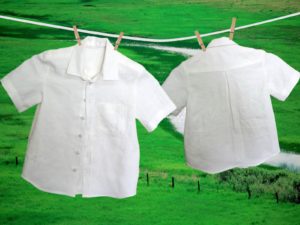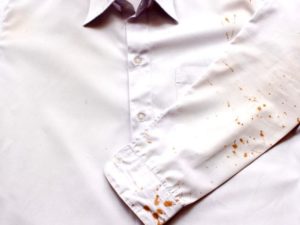 Shirts have become a part of both men's and women's wardrobes as casual and formal wear. The variety of modern styles allows you to use them in a wide variety of combinations: from classic business suits to democratic jeans and shorts. To ensure that shirts retain their original shape and color for a long time, and that collars and cuffs do not look shabby, it is very important to properly care for them, including washing them.
Shirts have become a part of both men's and women's wardrobes as casual and formal wear. The variety of modern styles allows you to use them in a wide variety of combinations: from classic business suits to democratic jeans and shorts. To ensure that shirts retain their original shape and color for a long time, and that collars and cuffs do not look shabby, it is very important to properly care for them, including washing them.
What are the features of automatic and manual shirt washing? What is the optimal water temperature? Is it possible to remove various stains and traces of sweat at home, and how to properly wring out and dry things?
How to wash a white shirt
 A white shirt requires special care. It is very important to wash it correctly, otherwise:
A white shirt requires special care. It is very important to wash it correctly, otherwise:
- it takes on a grayish, unsightly appearance and loses its shape;
- Old spots and yellow marks remain on it;
- Folds and creases may appear on the cuffs and collar.
All this leads to rapid failure of the product, the need to purchase a new item, and unnecessary expenses.
You can wash it in two ways: in an automatic washing machine or manually. In both versions, you must adhere to a number of simple rules.
How to properly wash shirts in a washing machine
To ensure that the appearance of the shirt does not deteriorate after washing, you must complete 3 successive steps:
- Preparation. Separate items by color to avoid color shedding between white and light colored items. Fasten all buttons, including the cuffs. This will prevent shirts from wrapping around the drum and getting tangled with other items. Check the pockets thoroughly and remove all contents. Turn the clothes inside out. Carefully study the information on labels about machine washability, optimal temperature conditions, whether it can be wrung out and dried, as well as other rules for handling the product.
- Soak. This procedure is necessary if the white shirt has turned gray or has stains that are difficult to remove. If your machine has a “Wash with Soak” mode, use it. If this mode is not available, soak the item manually: pour water into a basin, add washing powder, and dip the item. Rub the cuffs, collar and armpit area with laundry soap (if the shirt is white, you can use soda), then rub gently with a soft brush. Leave for 15–20 minutes. Rinse with water and vinegar. The item is ready for further washing.
- Wash. Place the prepared shirt in the washing machine. Pour half of the detergent required for washing into the powder compartment. Turn on the device in delicate mode for 2-3 minutes, then add the second half of the powder, pour in the conditioner in full.Turn the appliance back on to the delicate cycle. To whiten a shirt, you can add a small amount of hydrogen peroxide or soda (2 tablespoons) to the second detergent compartment.
To wash white clothes, you can use any powder marked “for automatic washing”, if there is no indication on it that it is intended for colored items. It is advisable to wash your shirts daily or at least every other day. This way they will not wear out, dirt and stains will not eat into the fabric. If the shirt is not very dirty, you can wash it in the “quick wash” mode.
Attention! Do not use the spin and dry functions when washing shirts in the washing machine. Squeeze them out with your hands, being careful not to twist them too much, otherwise the material may stretch out and change shape.
How to wash a shirt by hand
 If the label has an icon depicting a hand placed in a basin, the product is made of very delicate fabric, or you are not sure that the shirt can be washed in the washing machine, the item must be washed by hand. For this:
If the label has an icon depicting a hand placed in a basin, the product is made of very delicate fabric, or you are not sure that the shirt can be washed in the washing machine, the item must be washed by hand. For this:
- pour warm water into a basin;
- pour in washing powder;
- soak the product for 20–30 minutes;
- rub any dirt very carefully with your hands or a soft brush;
- if the dirt is strong, rub it with laundry soap, let it sit for another 20 minutes and rub gently again;
- rinse the shirt several times in cool, clean water;
- squeeze gently, being careful not to twist.
For greater whiteness, it is possible to add a little bleach that does not contain chlorine to the powder with softening agents.
Features of the washing procedure
To prevent washing from harming the product or spoiling it, it is important to know some of the features of this procedure and ensure strict adherence to all the recommendations indicated on the label.This concerns the choice:
- temperature conditions;
- type of washing – automatic, manual;
- drying method.
Properly followed recommendations will significantly increase the wear life of the shirt and preserve its original appearance for a long time.
At what temperature should I wash white and light shirts?
 When washing white and light shirts, it is very important to take into account the temperature conditions indicated on the product label. In any case, it should not exceed 40 °C. For most shirts, the optimal temperature is 30°C.
When washing white and light shirts, it is very important to take into account the temperature conditions indicated on the product label. In any case, it should not exceed 40 °C. For most shirts, the optimal temperature is 30°C.
At higher temperatures, there is a high risk of tissue deformation and changes in its structure. Cuffs and collars may lose their shape.
Important! If a white shirt is washed at temperatures exceeding 40 °C, it will lose its whiteness, acquire a gray tint, and look washed out.
Can shirts be washed in a washing machine if it is not indicated on the product label?
If there is no washing symbol on the label, you need to pay attention to the fabric from which the shirt is made. This will allow you to set the correct parameters on the washing machine or wash the item correctly by hand:
- Cotton. Both automatic and hand washing are acceptable. The product may shrink approximately 5% of its original size.
- Silk. Hand wash only without pre-soaking. The water temperature should not be higher than 30 °C.
- Woolen. Can be washed by hand or in a washing machine that has a wash cycle for wool items. You can't push too hard.
- Made from artificial fabrics (viscose, modal, etc.). Hand wash with cool water is recommended. Fabric shrinkage can be up to 7%.
- Synthetic (elasthane, lycra, polyamide, dacron, etc.). Can be washed in a washing machine at 40°C.
Use the appropriate detergent for each type of fabric. Cotton clothes can be washed with any universal powders, silk and wool require the use of special detergents for washing silk and woolen products, and artificial and synthetic shirts require soft detergents.
How should a washed shirt dry?
 It is not recommended to dry a washed shirt in a washing machine. This can lead to deformation of the collar and cuffs. Hang the hand-wrung product on hangers. Straighten the folds and sleeves. To ensure that the shape of the product does not change, it must be dried in natural conditions, away from heating devices. This drying procedure will make ironing easier in the future.
It is not recommended to dry a washed shirt in a washing machine. This can lead to deformation of the collar and cuffs. Hang the hand-wrung product on hangers. Straighten the folds and sleeves. To ensure that the shape of the product does not change, it must be dried in natural conditions, away from heating devices. This drying procedure will make ironing easier in the future.
Removing contaminants
On white shirts, some parts become dirty over time. Especially it concerns:
- a gate at which a yellow stripe appears at the break;
- cuffs, due to their frequent contact with various surfaces;
- armpit area where traces of sweat remain.
How to remove these contaminants?
How to remove yellow stripes from a man's shirt collar
 Yellow streaks appear due to sebum and sweat remaining on the collar due to friction against the neck. Dirt and dust settle on them, penetrating deep into the fabric and eating into it. Ironing additionally “welds” the dirt. It becomes quite difficult to wash it off.
Yellow streaks appear due to sebum and sweat remaining on the collar due to friction against the neck. Dirt and dust settle on them, penetrating deep into the fabric and eating into it. Ironing additionally “welds” the dirt. It becomes quite difficult to wash it off.
There are several most effective ways to get rid of the unpleasant yellow stripe on your collar:
- Laundry soap. Dip the collar in warm water. Apply soap to it thoroughly. Place the shirt in a plastic bag and leave for 1 hour. After the specified time, carefully rub the collar with your hands.If necessary, additionally carefully go over the collar with a soft brush. Rinse to remove all soap.
- Stain remover. Mix the product with a small amount of warm water. Finish the collar. After 5 minutes, rinse with cool water.
Advice! To remove a yellow stripe from the collar of a white shirt in the absence of a stain remover, you can use hair shampoo or dishwashing detergent, increasing the exposure time to half an hour.
After using one of the above methods, wash your shirt either by machine or by hand, depending on the type of fabric.
Effective ways to remove yellow spots
 How to wash white shirts that have yellow stains on them? Several effective ways using various means can help:
How to wash white shirts that have yellow stains on them? Several effective ways using various means can help:
- Ammonia. Mix 4 tbsp. spoons of warm water, table salt, ammonia. Apply to existing stains. Rub lightly and rinse with cool water. 2nd option: add the resulting composition to 1 liter of soap solution. Immerse your shirt in it for 30 minutes. Rub and rinse gently.
- Hydrogen peroxide 3%, liquid soap. Take 50 ml of peroxide, add 4 tbsp. l. liquid soap. Apply to the product. Leave for 40 minutes.
- Toothpaste. Works well on tough stains. Just lubricate the stained areas with paste, rubbing a little into the fabric. Leave for 15–20 minutes. Use only pure white paste, without any multi-colored additions!
After following one of the above methods, wash the shirt following the instructions on the label.
Important! The faster you wash a shirt with stains, the easier it is to get rid of them. Old stains are much more difficult to remove.
How to remove sweat marks from armpits
 Traces of sweat appearing in the armpits are quite difficult to get rid of. Often an almost new item has to be thrown away just because of these unsightly stains. There are several products that can remove them and are safe for fabric:
Traces of sweat appearing in the armpits are quite difficult to get rid of. Often an almost new item has to be thrown away just because of these unsightly stains. There are several products that can remove them and are safe for fabric:
- Soda, table salt, vinegar. Add 250 ml of vinegar to a bowl of hot water. Place the shirt and leave for 20 minutes. Mix 210 g of soda (about 1.5 cups) and 10 g of table salt (1 tablespoon). You can pour 10 ml of 3% hydrogen peroxide (1 tablespoon) into the mixture. Take out the shirt and wring it out a little. Apply salt and baking soda (and peroxide) to problem areas. Leave for another 20 minutes, then rinse and wash in an acceptable manner.
- White vinegar. Take ½ cup of the product, add to 1 liter of warm water. Place the shirt in the solution for 40 minutes. Rinse. If one time is not enough, the procedure can be repeated. This method allows you not only to get rid of traces of sweat from your armpits, but also to remove unpleasant odor.
- Lemon. Citrus is known for its whitening and disinfecting properties and is an environmentally friendly product. Just apply the juice of 1 lemon to your armpits, leave for 40 minutes, then wash. Another option: cut the lemon into thin slices and place in a bowl. Add 1 tbsp. l. hydrogen peroxide, pour warm water. Place the shirt in the basin for 1 hour, then rinse and wash.
Traces of sweat can be washed off more easily in soft water. You can soften the water by adding a small amount of baking soda or table vinegar.
Stains are not a problem
Some stains are easy to remove. With others you have to tinker quite a bit. It all depends on their nature, as well as how long ago the clothes were soiled. But even the most difficult stains can be removed.To do this you need to know some tricks.
How to wash gouache on a white shirt
First of all, carefully examine the stain. If the gouache has already dried and lies in a thick layer, try to carefully clean it with a soft brush, being careful not to rub the paint into the fabric. Then place the stained area under running cold water. Some of the gouache will wash off from clothes on its own. Apply soap to the remaining stain - laundry soap or Antipyatin, an oxygen stain remover. Leave the soap for 20–30 minutes, the stain remover for 5 minutes. Wash the item in an acceptable way, choosing a temperature setting of 30 °C.
Attention! When removing gouache stains from a white shirt, only cold water should be used throughout the entire procedure! Otherwise, the paint may eat into the fabric.
How to wash blood
 Blood is quite difficult to wash off, especially from white things. Wash clothes stained with blood only in cold water to avoid coagulation of the organic protein contained in the red cells.
Blood is quite difficult to wash off, especially from white things. Wash clothes stained with blood only in cold water to avoid coagulation of the organic protein contained in the red cells.
A fresh stain can be removed using:
- laundry soap, rubbing it on a cloth soaked in water and rinsing under running cold water;
- crushed aspirin tablets mixed with water and applied to the blood stain until dry, and then washed off with cold water;
- table salt, poured onto a thing soaked in water and left until absorbed, then also removed with water.
Dried blood is much more difficult to remove. A stain remover such as Vanish can help. Apply a few drops of product to the stained area. Wait 3-5 minutes, then wash the product by hand in cool water with washing powder.
Another remedy for old blood stains is glycerin. Apply it warm to the stain.Leave it on all night. You can wash your shirt in the morning, preferably by hand.
What products and methods are most effective in combating lipstick marks on a white shirt?
If there are traces of lipstick on a white shirt, then before washing it, you need to treat the stained area.

Information! The lipstick remover should be applied to the reverse side of the product to eliminate the risk of penetration and fixation of the fatty base into the fibers!
The most effective are 2 methods. They use:
- Ammonia. Moisten a cotton pad with it and wipe the stained area (from the inside out), from the middle of the stain to the edges. Use several pads until the lipstick is removed. Don't worry about the unpleasant smell of ammonia - it will disappear after washing.
- Hydrogen peroxide. Pour 3% peroxide solution onto the pigment. The lipstick mark will gradually fade. Repeat until the stain is completely gone. Rinse the shirt and dry it.
The methods are also suitable for getting rid of foundation and oil stains.
How to wash shirts correctly so that they retain their original appearance, whiteness, and freshness for a long time? Follow the tips given, take more careful care of your clothes, don’t wear things out, and they will serve you for a long time, bringing only positive emotions while wearing them.


 0
0





